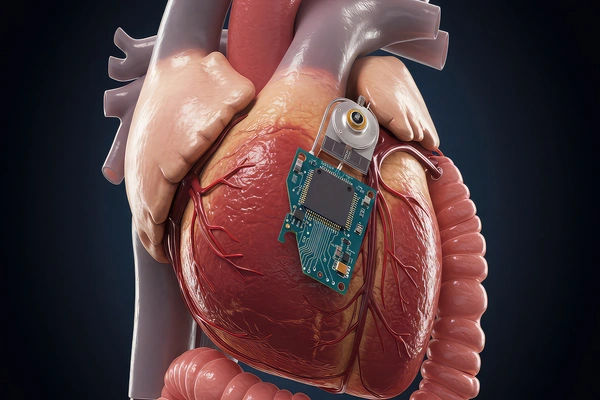Cesarean Awareness Month: A Complete Guide to Understanding Your Birth
Know about Cesarean Awareness Month, when it is, what it's important, reasons for cesarean, what to expect, and exploring vaginal birth. Learn about how to support Cesarean Awareness Month.

Written by Dr. J T Hema Pratima
Reviewed by Dr. Mohammed Kamran MBBS, FIDM
Last updated on 6th Oct, 2025

Introduction
Every April, the global community observes Cesarean Awareness Month, a dedicated time to shed light on one of the most common surgical procedures worldwide: the cesarean section. For many, a C-section is a life-saving intervention, but for others, it can be a source of confusion, unexpected recovery, or emotional complexity. This month is not about judging how a baby is born; it's about fostering education, support, and empowerment for all parents. Whether you're a soon-to-be parent wanting to be informed, someone recovering from a C-section, or a supporter looking to understand, this guide is for you. We'll delve into the reasons behind C-sections, the realities of recovery, both physical and emotional, and the important conversations around future births.
What is Cesarean Awareness Month and Why Does It Matter?
Cesarean Awareness Month is an initiative spearheaded by the International Cesarean Awareness Network (ICAN). Its core mission is to improve maternal and infant health by preventing unnecessary cesareans through education, providing support for cesarean recovery, and promoting Vaginal Birth After Cesarean (VBAC). It’s a critical movement in today’s obstetric landscape, where C-section rates in many countries are significantly higher than the 10-15% recommended by the World Health Organisation.
Health topic carousel:
Doctor's speciality: Obstetrician
Text: Consult an Obstetrician for Personalised Advice
The History and Mission of ICAN
Founded in 1982, ICAN is a non-profit organisation born from a need to support mothers who felt marginalised by their birth experiences. At a time when "once a cesarean, always a cesarean" was a common and often unchallenged mantra, ICAN advocated for evidence-based care and choice. Their work has been instrumental in making VBAC a safer and more accessible option for millions of women. The organisation provides a vital network of local chapters and online forums where parents can share stories, find resources, and access evidence-based information.
Key Goals: Reducing Stigma and Unnecessary Procedures
The month focuses on two parallel paths. First, it aims to reduce the stigma associated with C-sections, validating them as a legitimate and sometimes necessary form of birth. Second, it highlights the importance of reducing non-medically indicated cesareans. An unnecessary surgical birth can expose the mother and baby to avoidable risks, such as infection, blood clots, and complications in future pregnancies. By promoting informed consent and shared decision-making between patients and providers, Cesarean Awareness Month empowers individuals to be active participants in their healthcare.
Understanding Cesarean Sections: The Facts and Figures
A cesarean section is a surgical procedure to deliver a baby through incisions in the mother's abdomen and uterus. According to the CDC, the cesarean delivery rate in the United States was 32.1% in 2022. Understanding why they are performed is the first step in demystifying the process.
Common Medical Reasons for a C-Section
C-sections are crucial when the health of the mother or baby is at risk. Common indications include:
Labour Not Progressing: This is one of the most common reasons, where cervical dilation stalls or the baby doesn't descend despite strong contractions.
Fetal Distress: If monitors indicate the baby isn't getting enough oxygen.
Baby's Position: A breech (feet- or bottom-first) or transverse (sideways) position often necessitates a C-section.
Placenta Issues: Placenta previa, where the placenta covers the cervix, or placental abruption.
Multiple Pregnancies: While many twins are born vaginally, triplets or more, or certain twin positions, often require a C-section.
Maternal Health Conditions: Such as active genital herpes or a serious health condition like heart disease.
Planned vs. Unplanned Cesarean: What's the Difference?
The experience can vary greatly depending on whether the C-section was scheduled or occurred after labour began.
Planned (Scheduled) C-Section: This is decided upon before labour starts for a known medical reason. Parents have time to prepare mentally and physically, ask questions, and know what to expect on the day.
Unplanned (Emergency) C-Section: This decision is made during labour due to an unforeseen complication. The "emergency" label can be stressful, as it often involves a rapid change of plans and can lead to feelings of shock or disappointment. It's important to remember that "unplanned" does not mean "unnecessary"; it is a proactive measure for safety.
The Cesarean Recovery Journey: What to Expect
Recovery from a C-section is a major undertaking, as it involves healing from major abdominal surgery while caring for a newborn. Knowing what to expect can make the process less daunting.
The First 24-48 Hours: Hospital Care
Immediately after surgery, you will be monitored closely. You'll likely have a catheter, an IV for fluids and pain medication, and compression devices on your legs to prevent blood clots. Nurses will encourage you to get up and walk as soon as you are able, which is crucial for circulation and healing, even though it can be painful initially. If you experience severe pain, signs of infection like a fever, or excessive bleeding, it is crucial to inform your healthcare team immediately. For ongoing concerns after discharge, consulting a doctor online with Apollo24|7 can provide timely guidance.
The First 6 Weeks at Home: Physical Healing
Once home, the focus is on rest and gradual movement.
Pain Management: Take prescribed pain relievers on schedule to stay ahead of the pain.
Incision Care: Keep the incision clean and dry. Watch for redness, swelling, warmth, or pus, which are signs of infection after a C-section.
Movement: Avoid heavy lifting (anything heavier than your baby), strenuous exercise, and prolonged stair climbing. But do take short, gentle walks to aid recovery.
Support: This is non-negotiable.
Creating a Supportive Home Environment
Set up a "nest" on the main floor of your home with everything you and the baby need: diapers, snacks, water, phone charger, and pillows. Accept all offers of help for cooking, cleaning, and older child care. The mantra for recovery after a c-section is "I will not do anything except feed the baby and heal myself."
Beyond the Physical: Addressing Emotional Recovery
The emotional impact of a C-section is often underestimated. Whether planned or unplanned, it can bring a complex mix of feelings, from relief and gratitude to grief and disappointment.
Processing a Birth That Didn't Go as Planned
If you had envisioned a vaginal birth, an unplanned C-section can lead to a sense of loss or failure. This is a valid and common experience known as birth trauma. It's essential to acknowledge these feelings rather than dismiss them. Talking about your experience—with a partner, a therapist, or a support group like ICAN—can be incredibly healing. Reframing the experience not as a failure but as a strong, adaptive response to keep your baby safe can be a powerful step forward.
Recognising Signs of Postpartum Depression and Anxiety
The hormonal shifts and sleep deprivation of the postpartum period affect all new mothers. However, those who experience a traumatic birth may be at a higher risk for postpartum depression and anxiety. Symptoms include persistent sadness, anxiety, or "empty" mood, irritability, difficulty bonding with the baby, and overwhelming fatigue. If these feelings persist beyond two weeks and interfere with your ability to function, it is vital to seek help. Consulting a doctor online with Apollo24|7 can be a discreet and convenient first step to discuss these concerns and get a referral for support.
Future Pregnancies: Exploring VBAC (Vaginal Birth After Cesarean)
For many, a key question after a C-section is, "What about my next birth?" The old rule of "once a cesarean, always a cesarean" is no longer true for most people.
Is VBAC Right for You? Assessing the Possibilities
A VBAC can be a safe and successful option for about 60-80% of people who attempt it. Success rates are higher for those whose previous C-section was for a non-recurring reason (like a breech baby). Key factors include the type of uterine incision (low-transverse incisions are best for VBAC), the reason for the previous C-section, and the spacing between pregnancies. A detailed discussion with your obstetrician is essential to weigh your personal VBAC success rates and risks.
The Benefits and Risks of a Repeat C-Section
A planned repeat cesarean has its own set of pros and cons. Benefits include a scheduled date, avoiding the potential for another emergency surgery, and knowing what to expect from recovery. Risks include those associated with any major surgery and potential complications for future pregnancies, such as placenta accreta. The decision is deeply personal and should be made collaboratively with your healthcare provider based on your health, your baby's health, and your personal values.
How to Participate and Show Support During Cesarean Awareness Month
You don't need to have had a C-section to participate. Everyone can contribute to a more supportive environment.
Resources for Parents and Families
Share reputable resources from organisations like ICAN, the American College of Obstetricians and Gynaecologists (ACOG), and postpartum support groups. If you know someone who has recently had a C-section, offer practical support: bring a meal, watch the baby so they can shower, or simply listen without judgment.
Advocating for Your Birth Preferences
The best way to participate is to become informed. Whether you're planning a vaginal birth, a C-section, or a VBAC, learn about the evidence, know your options, and create a birth plan that outlines your preferences. Remember, a birth plan is a communication tool, not a rigid script. The ultimate goal is a healthy parent and baby, achieved through respectful, patient-centred care.
Conclusion
Cesarean Awareness Month serves as an annual reminder that how we enter the world, and how parents bring us into it, is a story worth honouring with compassion and facts. A cesarean section is neither a badge of honour nor a mark of failure; it is a medical tool that, when used appropriately, saves lives. Whether your birth was planned, unexpected, or still ahead of you, your experience is valid. Let this month be a catalyst for conversation, a source of comfort, and a step towards a future where every birth is met with knowledge, support, and respect. If you have questions about your recovery or are planning a future pregnancy, take the next step in your health journey by speaking with a specialist.
Health topic carousel:
Doctor's speciality: Obstetrician
Text: Consult an Obstetrician for Personalised Advice
Frequently Asked Questions
1. What is the most important thing for recovery after a C-section?
A.The single most important factor is accepting help and prioritising rest. Your body needs to heal from major surgery. Enlist partners, family, and friends to handle cooking, cleaning, and other chores so you can focus on feeding your baby and recovering.
2. How long does it take to fully heal from a C-section?
A.While you may feel significantly better within 6-8 weeks, internal healing can take 6 months to a year. It's normal to feel numbness or tingling around the scar for even longer. Listen to your body and gradually return to activities.
3. Can I have a vaginal birth after two c-sections?
A.A VBAC after two previous C-sections (VBA2C) is possible but is considered higher risk than a VBAC after one. It requires careful consultation with a supportive healthcare provider and often needs to be conducted at a hospital with appropriate resources. Success rates can still be favourable for good candidates.
4. Is it normal to feel disappointed about having a C-section?
A.Yes, it is completely normal. Many parents grieve the birth experience they had envisioned. These feelings are valid and should be acknowledged. Talking to a therapist or a support group can help you process these emotions healthily.
5. When should I be concerned about my C-section scar?
A.Contact your doctor if you notice increasing redness, swelling, warmth, pus-like drainage, or if the pain around the incision suddenly gets worse. These could be signs of infection after C-section* that need medical attention. A fever over 100.4°F (38°C) is also a red flag.
Consult Top Specialists for Personalised Tips

Dr. Sreeparna Roy
Obstetrician and Gynaecologist
8 Years • MBBS , MS (OBSTETRICS & GYNAECOLOGY), Fellowship in Infertility, Endoscopy & Ultrasonography), Fellowship in Laparoscopy & Hysteroscopy,DRM
Barasat
Diab-Eat-Ease, Barasat

Dr. Sangeetha M
Obstetrician and Gynaecologist
21 Years • MBBS, MS ( Obstetrics & Gynaecology )
Bansdroni
Siddhita Healthcare., Bansdroni

Dr. Somdutta Basu
Obstetrician and Gynaecologist
7 Years • MBBS, MS Obstetrics & Gynaecology
Bansdroni
Siddhita Healthcare., Bansdroni

Dr. Korimilli Nisha
Obstetrician and Gynaecologist
10 Years • MBBS, MS (Obstetrics and Gynaecology)
Bansdroni
Siddhita Healthcare., Bansdroni

Dr. Saheli Kapat
Obstetrician and Gynaecologist
11 Years • MBBS, DNB Obstetrics & Gynaecology,FMAS(Fellowship in Minimal access surgery)
Kolkata
MCR SUPER SPECIALITY POLY CLINIC & PATHOLOGY, Kolkata
Consult Top Obstetrics and Gynaecology

Dr. Sreeparna Roy
Obstetrician and Gynaecologist
8 Years • MBBS , MS (OBSTETRICS & GYNAECOLOGY), Fellowship in Infertility, Endoscopy & Ultrasonography), Fellowship in Laparoscopy & Hysteroscopy,DRM
Barasat
Diab-Eat-Ease, Barasat

Dr. Sangeetha M
Obstetrician and Gynaecologist
21 Years • MBBS, MS ( Obstetrics & Gynaecology )
Bansdroni
Siddhita Healthcare., Bansdroni

Dr. Somdutta Basu
Obstetrician and Gynaecologist
7 Years • MBBS, MS Obstetrics & Gynaecology
Bansdroni
Siddhita Healthcare., Bansdroni

Dr. Korimilli Nisha
Obstetrician and Gynaecologist
10 Years • MBBS, MS (Obstetrics and Gynaecology)
Bansdroni
Siddhita Healthcare., Bansdroni

Dr. Saheli Kapat
Obstetrician and Gynaecologist
11 Years • MBBS, DNB Obstetrics & Gynaecology,FMAS(Fellowship in Minimal access surgery)
Kolkata
MCR SUPER SPECIALITY POLY CLINIC & PATHOLOGY, Kolkata




_0.webp)